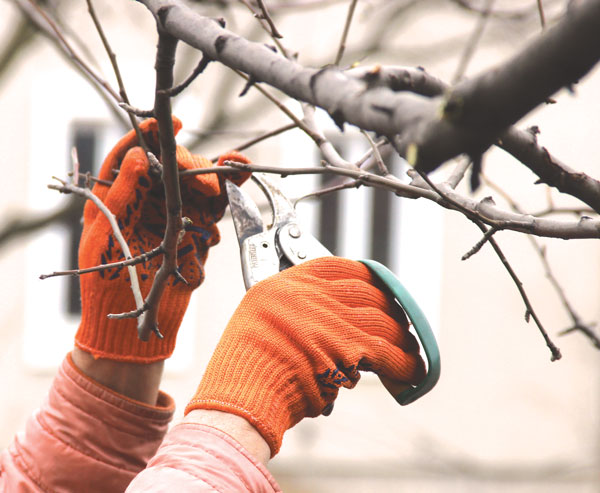Teach Your Trees
Establish good pruning habits for future success
By Anita Clevenger
January 2020
Trees grow in the wild without any human intervention. Our standards are higher for a tree that is growing in our yard. Attending to a tree’s structure improves its health, safety and aesthetics. Just as a stitch in time saves nine, a snip (or several) will save you time and money over the many years of a tree’s life.

During the winter months when a tree is dormant, grab a clean, sharp pair of hand pruners and get to work. It won’t take much. According to Sanchez, “One cut might be enough.” The Arbor Day Foundation recommends no more than five total cuts a year, regardless of a tree’s age.
One of the first steps is to assess the tree, identifying what type of tree it is, its natural shape and its health. Depending on the variety, trees can grow to be columnar, round, oval or have a naturally low canopy. Some trees grow more vigorously than others, so the amount of pruning needed will vary. You may spot dead, broken or crossing branches, or root suckers growing from the base of the tree. You should remove them at any time.
Here are some tips for pruning. Retain the lower branches during the first two years after planting because you want as many leaves as possible to generate new growth and to prevent the sun from burning the trunk. Throughout a tree’s life, leaves are essential to its health. A good rule of thumb is to remove no more than 25 percent of live growth at any one time.
Maintain the main vertical stem (central leader) on your tree. Never cut off its top. Remove or reduce competing vertical branches. Thin narrowly spaced branches as the tree matures. The Sacramento Tree Foundation advises, “each branch selected for removal should be cut outside the small ridge known as the branch bark collar located where the branch joins the trunk.” Don’t use any form of wound dressing over pruning cuts.
Don’t forget that young trees need regular, slow, deep watering during dry weather for the first three years. Mature trees generally need supplemental water, too, depending on their variety. Never assume that lawn sprinklers or drip irrigation will provide sufficient moisture to maintain a tree’s health. A layer of mulch will help preserve moisture.
When you plant a tree, you are making an investment for future generations. Just as you teach your children well, train your trees well too.
Two free pruning clinics will be offered by the Sacramento Tree Foundation in partnership with SMUD on Saturday, Jan. 11, at Robertson Park in Del Paso Heights, and Saturday, Feb. 1, at Garden Valley Elementary School in South Natomas. For details or to sign up, visit sactree.com/events. Information also is available at sactree.com/pruning with links to videos showing why and how to prune.
The Sacramento Master Gardeners will hold a pruning workshop on how to prune fruit trees, grapevines and berries on Saturday, Jan. 18, from 9 a.m. to noon at the Fair Oaks Horticulture Center, 11549 Fair Oaks Blvd. in Fair Oaks. For more information, visit sacmg.ucanr.edu.
Learn about rose pruning from world-renowned rose expert Stephen Scanniello on Saturday, Jan. 11, at 9 a.m. (climbing roses) and 1 p.m. (shrub roses) at the Historic Rose Garden in the Sacramento Historic City Cemetery, 1000 Broadway. Details are at www.cemeteryrose.org.
Anita Clevenger is a platinum Sacramento County Master Gardener. For answers to gardening questions, contact the UC Master Gardeners at (916) 876-5338 or mgsacramento@ucanr.edu, or visit sacmg.ucanr.edu. Follow us on Facebook, Twitter and Instagram: @insidesacramento.















